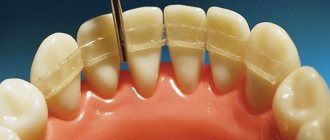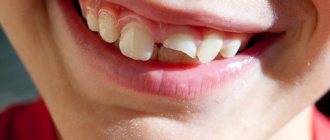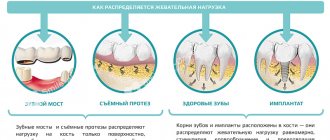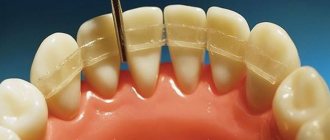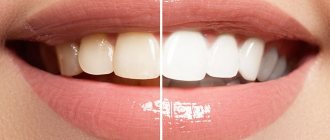From this article you will learn:
- why splinting of mobile teeth is carried out,
- methodology, reviews,
- splinting teeth – price 2022 in Moscow.
The article was written by a dental surgeon with more than 19 years of experience.
Splinting teeth is one of the methods for stabilizing the progression of chronic periodontitis, the purpose of which is to strengthen mobile teeth and reduce their mobility (due to special splinting structures). This goal can be achieved in two ways: firstly, by binding a group of teeth with fiberglass, and secondly, by using dentures. Below we will look at each of these methods in detail.
Features of the splinting procedure
In dentistry, there are many types of diseases that can potentially increase tooth mobility. This causes severe discomfort and negatively affects the condition of the jaw apparatus. It becomes difficult for a person to chew and he has to adhere to a special diet.
To solve this problem, you need to use a splinting technique. At its core, this is a procedure for strengthening teeth, which allows you to connect several units in a row and protect them from falling out.
The application of a splint is necessary so that there is not such a strong load on the gums, and other treatment methods can be freely applied. At the same time, it will be much more comfortable for the patient to chew different types of food.
Unloading tissue with splinting helps reduce the intensity of the inflammatory process. This is especially useful for periodontitis, when it is necessary to keep the gums in a calm state while doctors carry out general sanitation and restore damaged teeth.
In this material we will tell you in more detail how teeth splinting is done, what products are used in the process, and also touch on many other important issues regarding the procedure.
For what reasons does the dentition become mobile?
Doctors identify many reasons why patients need to be splinted. And these include such types of diseases as:
Periodontitis. The main reason for its appearance is poor oral hygiene, as well as the characteristics of the microflora. A strong build-up of tartar can often stimulate the inflammatory process and loosen teeth. In this case, there is a gradual destruction of the fixing ligament, which connects the tooth to other tissues.
- Periodontal disease. It can be quite easily determined by external examination. The gums become whitish, although any negative sensations and pain are practically not observed. Gradually, the volume of the gums decreases, and bare roots become very noticeable. Due to insufficient supporting tissues, the tooth begins to loosen over time. Periodontal disease is often observed in patients with a weakened body due to systemic diseases or long-term treatment.
- Injury. Problems can begin if a jaw fracture has been recorded.
Other categories of patients are also at risk. If you smoke a lot, neglect advice on regular oral hygiene, or suffer from metabolic disorders, you can develop severe tooth mobility. It also manifests itself due to age or poor nutrition.
Indications and contraindications for splinting
The decision about whether splinting can be performed in a particular case is made by the doctor. It is important that the technique has no contraindications and is effective.
There are several main common indications:
- Severe changes in the position of teeth or loosening due to periodontitis.
- Trauma – fractures of the upper or lower jaw.
- Reducing the volume of gum tissue.
- The gum pockets reach a size of 5 mm.
- Exposed roots.
There are also a number of contraindications for the procedure. Splinting cannot be performed when the patient has caries on the supporting teeth or severely inflamed gums. Also, restrictions are imposed if a person has too sensitive enamel or has a reaction to various materials of the system’s components.
It is also worth preparing for the fact that after splinting you will need to follow the rules of oral hygiene. Here the situation is similar to wearing braces - you will need to carefully monitor how well you brush your teeth.
How much does it cost
The cost of splinting in each region differs and depends on the material used and the length of the fixed dentition. The average cost of the procedure is presented in the table.
| Type of splinting | Price |
| Fiberglass | from 3500 rubles |
| Cable-stayed, using aramid thread | from 3000 rubles |
| Clasp prosthetics | from 25,000 rubles |
| Installation of metal-ceramic crowns | from 6000 rubles for 1 tooth |
| Installation of ceramic crowns | from 19,000 rubles for 1 tooth |
What materials are used when splinting a tooth?
The cost and other parameters of tire installation will greatly depend on what materials the system was made from. Let's look at the most common ones:
- Fiberglass thread. Fiberglass splinting of teeth is completed in just one and a half to two hours. You can expect at least three years of active use.
- Aramid fiber. Also in demand when performing splinting. It is valued for its careful attitude towards the enamel - after removal there is no damage left on it.
- Polyethylene. It is valuable because it is well tolerated by the mucous membrane and causes virtually no discomfort when worn even by sensitive people.
- Metal. Classic material for making retainers. Perfectly holds teeth in the desired position.
- Silk. This fiber can also be used; it is gentle on both mucous membranes and enamel, but is characterized by low strength.
- Ceramics. Typically used when permanent prosthetics are planned. Problems may arise due to the fact that the method is quite labor-intensive and expensive.
It is also possible to use metal-ceramics in the process. It is durable and quite affordable.
USING ARAMID FIBER
Also very popular is cable splinting of teeth with aramid thread, which has enormous strength. Experts have conducted several studies, during which it turned out that aramid fiber has eight times greater strength than piano steel with similar parameters.
- This technique allows you to achieve excellent aesthetics and correction of the dentition in case of displacements caused by periodontal diseases, injuries and other reasons.
- Aramid fiber is superior in durability to any other thread.
- The material does not enter into chemical reactions with saliva and food, and has excellent biocompatibility.
- Bone tissue stops rapidly atrophying.
- Large gaps between teeth are eliminated. Consequently, the space between them is not clogged and the overall aesthetics are improved.
- The natural load on the dentition is restored.
- You can simultaneously install dentures to replace lost teeth.
Benefits of the procedure
This procedure really helps to significantly reduce mobility and reduce stress on the gums. Periodontitis slows down, and restoration of normal chewing ability has a positive effect on the digestive process.
The procedure also has a positive effect on the patient’s personal comfort. The space between his teeth becomes smaller - this removes the psychological pressures that prevent many people from smiling normally.
Modern systems are designed so that you can talk in them calmly. Food restrictions are minimal.
Advantages
The splinting procedure has a number of advantages over prosthetics and coronation. Consequently, the dentist is looking for the opportunity to use splinting to treat gum disease. If it cannot be applied for some reason, other methods are used.
Main advantages
- Low cost of materials and procedure;
- The tooth does not wear down – minimal risk of developing caries;
- The splint does not interfere with the cleaning of gum pockets and other manipulations;
- Minimum pain after local anesthesia wears off;
- Possibility of bite correction;
- Does not create additional load on teeth and periodontium - minimal risk of bone tissue atrophy;
- Achieving results quickly.
Disadvantages of the method
The main disadvantage is that when installing the tire, you will need to carry out special mechanical processing of the enamel.
It is also worth considering that the product cannot be used by all patients. Much depends on the patient himself. He needs to be attentive to oral hygiene and brush his teeth on time. Otherwise, the risk of caries occurring and developing is very high. Hygiene itself will also become more difficult.
When installing a tire, you need to remember the adaptation process. During the first few days, there may be severe tooth sensitivity to sour, hot and cold foods.
Types of teeth splinting
There are many parameters to classify such a procedure. One of the main ones is location. The tire can be installed in two options:
- Frontal. Usually placed in the gap next to the incisors and canines.
- Lateral. Placed on a group of chewing teeth.
It is also possible to install a special clasp design - it is more expensive, but allows you to use both jaws.
Another difference parameter is the division into permanent and temporary splinting. Typically, a temporary option is indicated when the disease is just beginning to develop and the gums have not become too thin. This type of splinting is also allowed when there are injuries and deformations of the dentition.
An option with permanent splinting is also possible, when long-term stabilization is ensured. When choosing between a clasp prosthesis and permanent splinting, many patients prefer the first option because it is more aesthetically pleasing.
As the name implies, temporary and permanent structures differ in terms of wearing time:
- Temporary. Typically used between a few days and several months. This option allows you to correctly distribute the load and prevents serious damage to the mucous membrane. The design itself is quite simple, so it can be easily put on and taken off. Depending on the patient's current condition, the number of units to be splinted is selected. Common materials used in manufacturing are plastic and metal.
- Permanent. Suitable if you need to fix a tooth for many years. The advantage is that a truly reliable fixation is created, and the time spent adapting to such a design is greatly reduced.
You need to understand that the process of oral hygiene when using permanent prosthetics will become more difficult. You also need to pay attention that all tasks within the framework of dental treatment must be completed before the splint is installed - then it will be much more difficult.
Features of fixation of anterior / posterior and upper / lower teeth
Splinting of chewing teeth
The method of fixing loose teeth using aramid thread and fiberglass rope depends on their location.
The lower front teeth are anesthetized, after which grooves no more than 2 mm deep and 1.5 mm high are drilled into them. The tire is then placed inside the furrow and covered with composite. The number of teeth connected to each other depends on their stability in the gums. In addition to the loose ones, the tire pulls together two stable teeth along the edges of the fixed row.
Fixing the upper front teeth prevents them from fanning out as a result of loosening. The groove is drilled to the same size, however, it is placed on the outside. After the splint is laid, it is covered with a composite. This method of fixation allows you to minimize the interdental space. The length of the splint is determined by the general picture of the condition of the teeth.
Reference! Fixation of lateral teeth differs in that the splint is applied to the chewing surface. The dimensions of the groove are the same as those of the anterior dentition.
Teeth splinting methods
At the first appointment, the dentist assesses the current condition of the oral cavity and takes an x-ray. The task before him is to understand how much the bone tissue has thinned. You also need to determine the degree of tooth mobility, see what condition the bite is in, and whether there are any irregularities or other problems.
The condition of the gums is also of great importance, because it allows you to understand what methods can be used for splinting, what are the risks of irritation or other problems arising.
Installation of a splint is allowed only if there are no contraindications for this and no inflammation is observed. Sanitation of the oral cavity and treatment of caries may also be required. This becomes especially important when the installation of permanent permanent structures is planned.
Splinting using fiberglass
Fiberglass splinting is one of the most common methods. It is usually used when you need to connect several teeth and save as much as possible. The duration of use of one tire does not exceed two years - after this period it will be necessary to install a new one.
The entire installation process does not take more than two hours. First you need to clean the enamel, then create a small groove on it. After this, the fiberglass tape is fixed to the composite materials. After the structure is polished, the doctor is convinced that nothing is bothering the patient, the work is considered completed.
This technique is needed in order to splint teeth in case of periodontal disease. The choice of this method is supported by a high level of strength, good compatibility with dental tissues and affordability.
Screw method
The main material for this splinting is armid thread. This method can be used when a person is injured.
Splinting teeth for jaw fractures and increased mobility allows you to get noticeable results.
The installation process is similar to what has already been described above. First, the enamel is cleaned, then a groove is created. A cord of armid thread is stretched in the recess.
Clasp remedy
This technique refers to methods of permanent prosthetics and is suitable if you need to stabilize the dentition with severe loosening.
The use of modern means makes it possible to prepare abutments and crowns so that large gaps between teeth can be prevented.
Securing crowns
The product is suitable for you if you need to fix four teeth in a row at once. In this case, you will need to install crowns that connect. The installation is the same as in the cases described above. The main difference is the laboratory installation of crowns, as well as their fitting before placing them on permanent cement.
Splinting for periodontitis
This splinting option will be used if there is severe destruction of bone tissue. In this case, you need to apply a splint as quickly as possible in order to qualitatively reduce mobility and prevent further progression of tissue atrophy.
Splinting for injuries
Splinting teeth for fractures is a common practice. In this case, the doctor is tasked with preventing the manifestation of asymmetry. Temporary restorations are often prescribed to restore the correct position of the teeth throughout the recovery period.
Splinting after braces
Sometimes splinting must be used after the patient removes braces. In this case, the tire acts as a retainer. It allows you to prevent tooth displacement, which could lead to spoiling the result of many months of treatment.
Technique for creating a groove: stages
- At the initial stage, dental deposits are removed from the surfaces intended for splinting, and then they are polished with paste.
- Using special foil or another method, measure the working length of the reinforcement.
- Cut the tape to the required length. Polyethylene tires are cut with scissors, which are included in the complex. In the case of fiberglass, the bond is applied to the end of the measured section, and cut off after polymerization in the hardened part, otherwise the tape will unravel.
- The next step is to etch the enamel with half gel. This option is preferable to gel because it is easily washed off and does not leave silicon oxide particles on the surface, which impairs adhesion to the tire.
- A bonding system is applied to the tooth surface and polymerization is performed.
- A light-curing composite is applied, preferably of a fluid consistency, so that it better saturates the tire.
- A tape treated with adhesive, but not polymerized, is applied to the surface. By pressing the strip tightly, polymerization is performed.
- Adaptation is possible in two ways. The splint is pressed against the surface of the teeth and dental spaces and polymerized for 1-2 seconds. LED lamp. The second option is to pass pieces of floss between the teeth, pressing the tape against the teeth, and then perform polymerization.
- Composite material is applied to cover the reinforcement. Polymerization is carried out.
- The surface is polished, similar to a composite restoration.
Make an appointment to install a splint on your teeth
If you have an indication for teeth splinting, make an appointment with our clinic. Clients come to us from different cities - Khimki, Kurkino, Novogorsk and many others.
We guarantee a professional approach from dentists with extensive experience, fast treatment and the use of high-quality materials.
To make an appointment for your first consultation and examination with a dentist, simply leave a request on the website or call us. We will answer your questions and tell you which treatment option is right for your situation. We also provide many other services in the field of medical or aesthetic dentistry.


